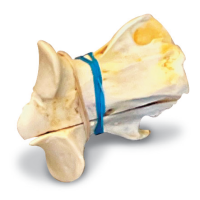
Sparking an Interest
Inaugural summer program provides hands-on experiences for middle and high schoolers to encourage interest in veterinary medicine

Dr. Carrie Finno picked up a coiled rope from a table covered with horse bones, enteroliths (stones that can form in a horse’s gut), alfalfa cubes and a bag of horse teeth.
She held one end of the rope and handed the rest to the high school student on her right who passed it along to the next student until the entire length of rope encircled the room.
“You’re holding the equivalent of the small intestine of a horse,” Finno told the 21 students who were visiting the Center for Equine Health (CEH) as part of the week-long Vet Med Summer Academy. “That’s about 70 feet long!”
Many of the students had never touched a horse until that day, let alone imagined what the internal anatomy or skeletal structures of a horse looked like.

“A lot of these students may not have any exposure to veterinary medicine or the opportunity to learn more about the field,” said Monae Roberts, chief diversity officer for the school. “This is a way to give them an experience to see if it sparks an interest for them.”
A lot of these students may not have any exposure to veterinary medicine or the opportunity to learn more about the field.”
—Monae Roberts, chief diversity office
While the school has conducted various Vet Med Summer Academies over the years for 4th and 5th grades, this is the first year of a pilot program for underrepresented students in 6th through 12th grades. In partnership with the nonprofit Breakthrough Sacramento and UC Davis’ Early Academic Outreach Program, 21 Sacramento-area students visited the Davis veterinary school campus every day to participate in hands-on activities, clinical skills labs, facility tours, faculty presentations and more.
Transportation, meals and program costs were covered for participants, thanks to generous donor funding, as well as financial support from the dean’s office, the School of Education, the campus provost, and a grant from the university’s Public Impact Research Initiative. The program also brought in Drs. Terrence Ferguson and Vernard Hodges, hosts of the popular “Critter Fixers” series on Disney+ and Nat Geo WILD for two days.
There weren’t Black veterinarians where I grew up as role models.”
——Dr. Terrance Ferguson (Critter Fixers)

Ferguson and Hodges shared their stories of overcoming adversity to attain their dreams of becoming veterinarians. Hodges grew up in a single wide trailer on a red dirt road in Georgia and failed 9th grade. His high school had two proms—one for White students, another for Black.
“There weren’t Black veterinarians where I grew up as role models,” Hodges said. “Nobody in the neighborhood took their animals to a veterinary clinic, so I didn’t know what they looked like.”
As an 8-year-old, Ferguson decided he wanted to be a veterinarian after he thought he saved his dog’s life. In truth, it was just cleaning up a bit of road rash on the dog after a minor accident with a car, he joked, nothing life threatening. So he went to local clinics, looking for a chance to shadow a vet. But it took a long time before he saw a veterinarian that looked like him.
“Representation matters,” Ferguson told the students. “It’s important to find someone who looks like you as a mentor. This program is extending a hand to help you in your journey. Reach back and extend your hand to others— it’s never too early to be a mentor.”
Representation matters. It’s important to find someone who looks like you as a mentor.”
—Dr. Terrance Ferguson (Critter Fixers)
He led the students in an exercise to help solve a case a veterinarian may see in a clinic. He took them through a series of clues: hardness in the abdomen detected during the physical exam; blood in urine; and finally, X-rays showing white calcifications in the bladder. Throughout the presentation, he engaged students in critical thinking skills, learning canine anatomy and problem solving.
The week was an eye-opening one for Rubi L., a senior at Florin High School who currently volunteers at a local animal shelter and wants to be a vet.

“In this program, I’m learning what to expect in veterinary school,” she said. “I’ve been taking a lot of notes, asking questions and getting a lot of helpful tips on what I’ll need to apply in several years. And it was really cool to touch a horse for the first time.”

It was really cool to touch a horse for the first time.”
—Rubi L., student
While there is no way of knowing yet what kind of lasting impact the program may have on any of the students who participated in the inaugural Vet Med Summer Academy, Roberts said she hopes it made a difference.
“Many of them are on a path to become first generation college students, so we’re going to keep track of whether they eventually consider veterinary medicine as a career after participating in this program,” she said.
